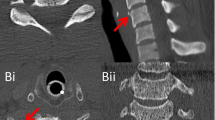Abstract
Objectives
About 800,000 cervical X-rays for trauma are taken every year in the USA. Those X-rays are reviewed by orthopedic specialists in the emergency room (ER) for traumatic findings. The quantity of incidental atraumatic findings in this very prevalent examination is unknown. We sought to determine the incidence of those findings.
Methods
We retrospectively reviewed 521 consecutive cervical X-rays of patients with a whiplash injury that visited our ER from February to July 2010. X-rays that were technically insufficient were excluded. This left 356 X-rays that met the inclusion criteria, which were analyzed for incidental findings. The examinations were reviewed by five staff radiologists for incidental findings. The findings were reviewed and classified.
Results
We identified incidental X-ray findings in 22 of the 356 patients (6.2 %) who underwent X-ray of the cervical spine during their visit to the ER. Stenosis with disk narrowing was the most common finding (2.8 %), followed by congenital anomaly of the cervical spine (2.2 %). Other findings were enlarged sella turcica (0.6 %), carotid atherosclerosis (0.3 %), and calcification of the stylomastoid ligament (0.3 %). Older age was found to be a risk factor for an incidental finding (p < 0.0001).
Conclusion
Incidental findings in the cervical spine were associated with older age. Awareness of the prevalence of incidental findings is important in order to ensure that they are detected and managed appropriately.

Similar content being viewed by others
References
Barnsley L, Lord S, Bogduk N. Whiplash injury. Pain. 1994;58:283–307.
Holm LW, Carroll LJ, Cassidy JD, et al. The burden and determinants of neck pain in whiplash-associated disorders after traffic collisions: results of the Bone and Joint Decade 2000–2010 Task Force on Neck Pain and Its Associated Disorders. Spine. 2008;33(4 Suppl):S52–9.
Spitzer WO, Skovron ML, Salmi LR, et al. Scientific monograph of the Quebec Task Force on Whiplash-Associated Disorders: redefining “whiplash” and its management. Spine. 1995;20:1S–73S.
Nordin M, Carragee EJ, Hogg-Johnson S, et al. Assessment of neck pain and its associated disorders: results of the Bone and Joint Decade 2000–2010 Task Force on Neck Pain and Its Associated Disorders. Spine. 2008;33(4 Suppl):S101–22.
Hoffman JR, Mower WR, Wolfson AB, Todd KH, Zucker MI. Validity of a set of clinical criteria to rule out injury to the cervical spine in patients with blunt trauma. National Emergency X-Radiography Utilization Study Group. N Engl J Med. 2000;343:94–9. Erratum in N Engl J Med 2001;344:464.
Barboza R, Fox JH, Shaffer LE, Opalek JM, Farooki S. Incidental findings in the cervical spine at CT for trauma evaluation. AJR Am J Roentgenol. 2009;192:725–9.
Sanchez B, Waxman K, Jones T, Conner S, Chung R, Becerra S. Cervical spine clearance in blunt trauma: evaluation of a computed tomography-based protocol. J Trauma. 2005;59:179–83.
Camp JD. The normal and pathologic anatomy of the sella turcica as revealed at necropsy. Radiology. 1923;1:65–73.
Edwards WC, LaRocca H. The developmental segmental sagittal diameter of the cervical spinal canal in patients with cervical spondylosis. Spine. 1983;8:20–7.
Witteman JC, Kok FJ, van Saase JL, Valkenburg HA. Aortic calcification as a predictor of cardiovascular mortality. Lancet. 1986;2(8516):1120–2.
Barrett TW, Schierling M, Zhou C, et al. Prevalence of incidental findings in trauma patients detected by computed tomography imaging. Am J Emerg Med. 2009;27(4):428–35.
Eskandary H, Sabba M, Khajehpour F, Eskandari M. Incidental findings in brain computed tomography scans of 3000 head trauma patients. Surg Neurol. 2005;63:550–3.
van Vugt R, Dekker HM, Deunk J, et al. Incidental findings on routine thoracoabdominal computed tomography in blunt trauma patients. J Trauma. 2011.
Ekeh AP, Walusimbi M, Brigham E, Woods RJ, McCarthy MC. The prevalence of incidental findings on abdominal computed tomography scans of trauma patients. J Emerg Med. 2010;38(4):484–9.
Morishita Y, Naito M, Hymanson H, Miyazaki M, Wu G, Wang JC. The relationship between the cervical spinal canal diameter and the pathological changes in the cervical spine. Eur Spine J. 2009;18(6):877–83.
Rennenberg RJ, Kessels AG, Schurgers LJ, van Engelshoven JM, de Leeuw PW, Kroon AA. Vascular calcifications as a marker of increased cardiovascular risk: a meta-analysis. Vasc Health Risk Manag. 2009;5:185–97.
Huang JH, Zager EL. Thoracic outlet syndrome. Neurosurgery. 2004;55:897–903.
Ellis MH, Manor Y, Witz M. Risk factors and management of patients with upper limb deep vein thrombosis. Chest. 2000;117:43–6.
Weisberg LA, Zimmerman EA, Frantz AG. Diagnosis and evaluation of patients with an enlarged sella turcica. Am J Med. 1976;61:590–6.
Messersmith WA, Brown DF, Barry MJ. The prevalence and implications of incidental findings on ED abdominal CT scans. Am J Emerg Med. 2001;19:479–81.
Paluska TR, Sise MJ, Sack DI, Sise CB, Egan MC, Biondi M. Incidental CT findings in trauma patients: incidence and implications for care of the injured. J Trauma. 2007;62(1):157–61.
Bird S. Failure to follow up CT reports. Aust Fam Physician. 2007;36:949–50.
Conflict of interest
No author has any conflict of interest.
Author information
Authors and Affiliations
Corresponding author
Rights and permissions
About this article
Cite this article
Koren, L., Simonovich, A., Norman, D. et al. Do cervical spine X-rays for trauma have clinically significant incidental findings?. Eur J Trauma Emerg Surg 39, 477–480 (2013). https://doi.org/10.1007/s00068-013-0290-6
Received:
Accepted:
Published:
Issue Date:
DOI: https://doi.org/10.1007/s00068-013-0290-6




